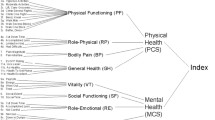Abstract
This paper compares the sensitivity to change of a multi-item, multi-dimensional health status measure with a single global health status question, in the assessment of treatment for menorrhagia. A cohort study of patients recruited by general practitioners, was carried out, with a follow up at eighteen months. Questionnaires were administered postally at baseline and follow up. General practices in Berkshire, Buckinghamshire, Northamptonshire and Oxford-shire supplied three hundred and nine women who reported heavy menstrual bleeding, and received either drug treatment alone or both drug and surgical treatment (endometrial resection or hysterectomy) during the eighteen months between the two admini-strations of the questionnaires. A single global question was given to patients asking them to rate their overall health status as ‘excellent’, ‘very good’, ‘good’, ‘fair’ or ‘poor’. The eight dimensions of the SF-36 health survey questionnaire were also given to patients to complete. The dimensions of the SF-36 indicated only small levels of improvement for patients who received drug treatment. However, on many dimensions of the SF-36, a moderate to large improvement was detected for the surgical group. However, small changes were reported in overall health status, as indicated by the single global question, for both groups. Single item measures of health status may not provide a sufficiently accurate indication of health status to be appropriate for use in longitudinal studies.
Similar content being viewed by others

References
Thier SO. Forces motivating the use of health status assessment measures in clinical settings and related clinical research. Med Care 1992; 30: MS15–22.
Nelson EC, Landgraf JM, Hays RD, Wasson JH, Kirk JW. The functional status of patients: how can it be measured in physicianś offices? Med Care 1990; 28: 1111–26.
Ware J. Preliminary tests of a 6-item general health survey. In: Stewart AL, Ware JE, eds. Measuring Functioning and Well-being: The Medical Outcomes Study Approach. London: Duke University Press, 1992.
Tarlov AR, Ware JE, Greenfield S, Nelson EC, Perrin E, Zubkoff M. The Medical Outcomes Study: an application of methods for monitoring the results of medical care. JAMA 1989; 262: 925–30.
Spilker B. Introduction. In: Spilker B, ed. Quality of Life Assessment in Clinical Trials. New York: Raven Press, 1990.
Cunny KA, Perry M. Single item vs multiple-item measures of health related quality of life. Psychol Rep 1991; 61: 127–30.
Kazis LE, Anderson JJ, Meenan RF. Effect sizes for interpreting changes in health status. Med Care 1989; 27: S178–89.
Jenkinson C, Wright L, Coulter A. Criterion validity and reliability of the SF-36 in a population sample. Quality Life Res 1994; 3: 7–14.
Doll HA, Black N, Flood AB, McPherson K. Criterion validation of the Nottingham Health Profile: patient views of surgery for benign prostatic hypertrophy. Soc Sci Med 1993; 37: 115–22.
Gough IR, Furnival CM, Schilder L, Grove W. Assessing the quality of life of patients with advanced cancer. Eur J Cancer Clin Oncol 1983; 19: 1161–5.
Rowan K. Global questions and scores. In: Jenkinson C, ed. Measuring Health and Medical Outcomes. London: UCL Press, 1994.
Ziebland S. Measuring changes in health status. In: Jenkinson C, ed. Measuring Health and Medical Outcomes. London: UCL Press, 1994.
Ware JE, Sherbourne C. The MOS 36-Item Short-Form Health Survey 1: conceptual framework and item selection. Med Care 1992; 30: 473–83.
Lydick E, Epstein RS. Interpretation of quality of life changes. Quality Life Res 1993; 2: 221–6.
Cohen J. Statistical Power Analysis for the Behavioral Sciences. New York: Academic Press, 1977.
Siu AL, Ouslander JG, Osterweil D, Reuben DB, Hays RD. Change in self-reported functioning in older persons entering a residential care facility. J Clin Epidemiol 1993; 46: 1093–101.
Beaufait DW, Nelson EC, Landgraf JM, Hays RD, Kirk JW, Wasson JH, Keller A. COOP measures of functional status. In: Stewart M, Tudiver F, Bass MJ, Dunn EV, Norton PG, eds. Tools for Primary Care Research, Research Methods for Primary Care, Volume 2. London: Sage, 1992.
Author information
Authors and Affiliations
Rights and permissions
About this article
Cite this article
Jenkinson, C., Peto, V. & Coulter, A. Measuring change over time: a comparison of results from a global single item of health status and the multi-dimensional SF-36 health status survey questionnaire in patients presenting with menorrhagia. Qual Life Res 3, 317–321 (1994). https://doi.org/10.1007/BF00451723
Received:
Accepted:
Issue Date:
DOI: https://doi.org/10.1007/BF00451723



